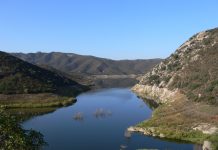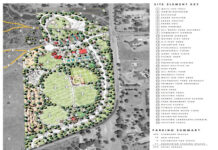The San Diego County Water Au¬thority has a program called the Transitional Special Agricultural Water Rate, and the SDCWA will be transitioning the TSAWR into a permanent program.
A unanimous CWA board vote Nov. 21 approved making the SAWR permanent. An annual review of the SAWR will be conducted in conjunc¬tion with other rates and charges, and the cost of service process to determine SAWR rates is expected to be completed in spring 2020.
“I just think it’s a win for agricul¬ture in San Diego,” said Frank Hil¬liker, who chairs the CWA’s Admin¬istrative and Finance Committee and also chairs the CWA’s Fiscal Sustainability Task Force.
Hilliker is on the board of the Lakeside Water District and is that district’s representative on the CWA board. He and other family members own the egg ranch his grandfather founded in 1942; that ranch utilizes well water and was not involved in the TSAWR pro¬gram or its predecessor. Hilliker is also a past president of the Lake¬side Chamber of Commerce.
In 1994 the Metropolitan Water District of Southern California (MWD) implemented the Inter-im Agricultural Water Program (IAWP) which provided surplus supplies to agricultural customers at a discounted rate with the condi¬tion of cutbacks in a drought of up to 30 percent prior to implementing any mandatory reductions to mu¬nicipal and industrial customers. An agricultural user could choose to pay municipal and industrial (M&I) rates and not be subject to the cutbacks.
In October 2008 the MWD board voted to phase out the IAWP over a four-year period. In December 2008 the CWA board created the TSAWR program for farmers who chose to opt out of the IAWP. TSAWR customers are not eligible to receive certain water from CWA augmented supply programs. The initial TSAWR was for a two-year pe¬riod although in March 2010 the CWA board voted to extend the program to the end of 2012, have a revised program for 2013 through 2015, and review that program prior to the begin¬ning of 2016. In April 2012 the CWA board voted to extend the TSAWR until the end of 2014.
In May 2013 the CWA con¬vened the Fiscal Sustainability Task Force whose purpose was to provide a revised rate struc¬ture intended to avoid a situa¬tion where conservation results in increased water rates due to reduced revenue from water pur¬chases by member agencies. The task force’s report was released to member agencies in January 2014 for their input and was first brought to the CWA board as an information item in Febru¬ary 2014. The board expressed a preference to defer action until outstanding issues could be ad¬dressed. The desire to include the TSAWR as part of the changes resulting from the task force recommendations led to a one-year extension of that program in June 2014 when the CWA’s 2014-15 budget was approved. In March 2015 the CWA board ap¬proved several of the task force’s recommendations and extended the TSAWR until the end of 2020.
The Fiscal Sustainability Task Force was reconvened in July 2019 and has been meeting twice each month. Valley Cen¬ter Municipal Water District general manager is the vice-chair of the task force which also includes Carlos Lugo of the Helix Water District, Kimberly Thorner of the Olivenhain Wa¬ter District, Mark Watton of the Otay Water District, Doug Wil¬son of the Padre Dam Municipal Water District, City of San Di¬ego representatives Chris Cate and Matt Vespi, and Mike Hogan of the Santa Fe Irrigation Dis¬trict. Although the task force is addressing other subjects, the TSAWR was the focus of mul¬tiple meetings. The October 25 task force meeting included a presentation from the CWA’s cost of service consultant.
The task force recommended that the TSAWR be made per¬manent, and the Administrative and Finance Committee also made such a recommendation prior to the full board vote.
“It’s no longer transitional, and it’s going to be opened up for new farmers,” Hilliker said.
“There was a great response. Everybody understands the im¬portance of agriculture in San Diego,” Hilliker said. “I’m just really proud of the board mem¬bers of the Water Authority and the hard work that staff put in getting it done.”
The November 21 CWA board approval is for the framework only; the specific rates will be part of the budget process. SAWR customers will pay the MWD Tier 1 untreated supply rate, the melded treatment rate, the transportation rate, the Cus¬tomer Service Charge which is intended to recover costs which support the operations of the CWA, and the Infrastructure Access Charge which is used for CWA fixed expenditures in¬curred even when water use is reduced and is per meter equiva¬lent rather than based on usage volume. SAWR customers will not pay the melded supply rate which reflects water purchased from the Imperial Irrigation District (IID) under the Quanti¬fication Settlement Agreement (QSA) and water produced by the Claude “Bud” Lewis Carls¬bad Desalination Plant as well as water delivered from MWD, the Storage Charge which recovers costs related to emergency stor¬age programs, the Supply Reli-ability Charge, or other charges related to regional conveyance.
The new program will take ef¬fect on January 1, 2021. During the first half of 2020 the CWA will develop and finalize new program guidelines, and new sign-ups will be initiated during the second half of 2020.













